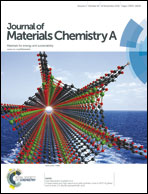Structure and properties of MgMxCr2−xO4 (M = Li, Mg, Ti, Fe, Cu, Ga) spinels for electrode supports in solid oxide fuel cells
Abstract
Novel electrode scaffold materials based on chromium-rich spinels, such as MgMxCr2−xO4, (M = Li, Mg, Ti, Fe, Cu, Ga) have been investigated for solid oxide fuel cell (SOFC) applications, in terms of conductivity and chemical stability when operated in fuel environments. Cation distributions were obtained by Rietveld refinement from X-ray diffraction data (XRD), with cation site preference considered in agreement with literature, and correlated with electrical properties determined experimentally. The substitutions with cations such as Li and Cu on B site improved the conductivity of the materials in air, while introducing Fe and Ga in the structure led to a decrease in conductivity in air. However, Fe had a positive contribution under reducing conditions, generating a change in the conductivity mechanism from p-type in air, to n-type. Conductivity measurements indicated that MgFexCr2−xO4 spinels exhibit faster reduction kinetics, in comparison with other substituted cations at the B site which is desirable in fuel cell application, for a reasonably fast response of a cell or a stack to reach its full functional potential. MgFeCrO4 showed fast reduction kinetics, with increase of the conductivity in reducing conditions from 0.014 S cm−1 to 0.4 S cm−1 and equilibration time for reaching the maximum conductivity value of 10 hours, under dry 5% H2/Ar at 850 °C.


 Please wait while we load your content...
Please wait while we load your content...